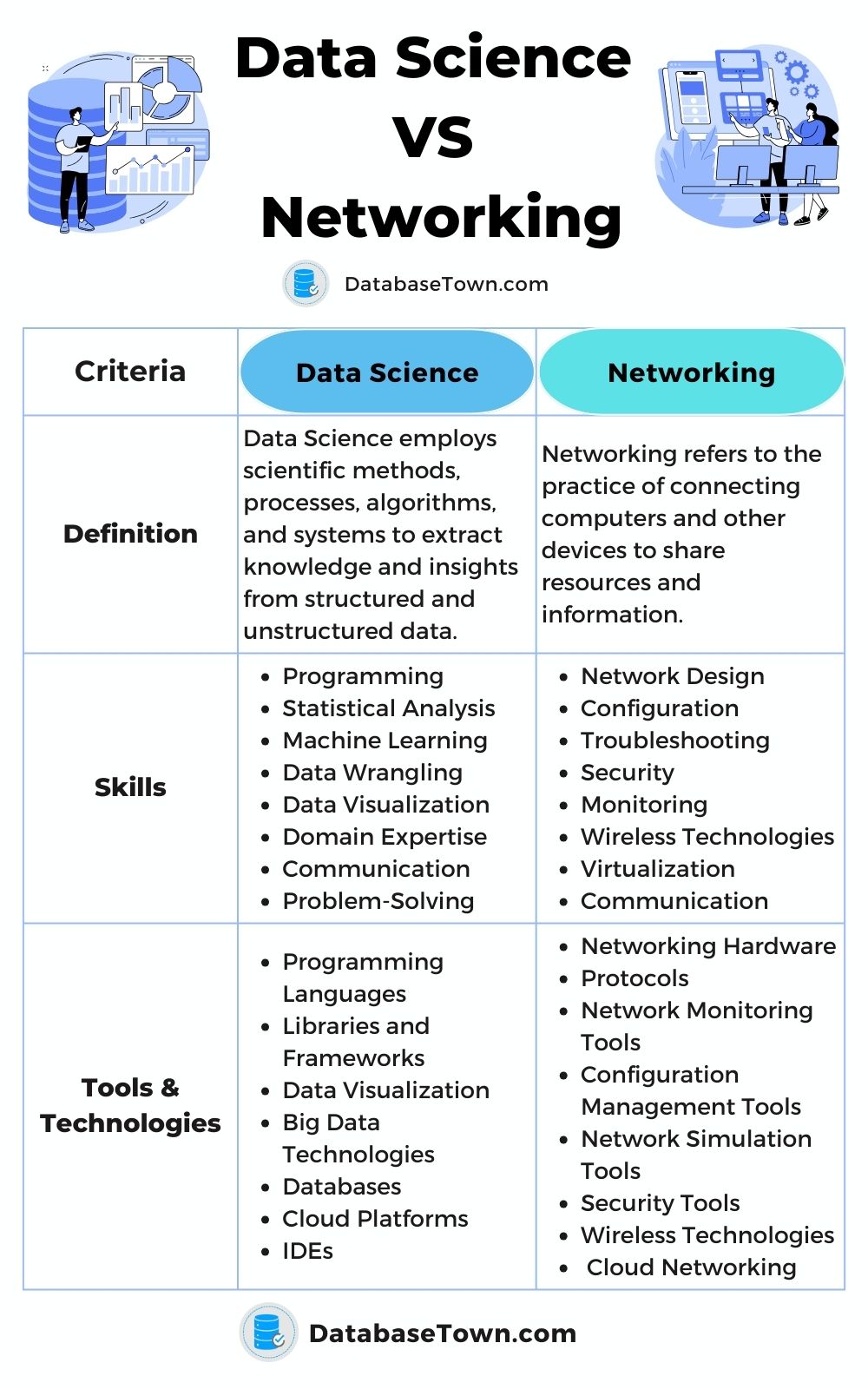
Difference Between Data Science VS Networking
Data Science and Networking are two fundamentally different and interdependent fields within the broader field of Information Technology (IT).
Data Science focuses on extracting insights from data using statistical and computational techniques whereas Networking is concerned with the design, implementation, and management of interconnected systems that facilitate data communication. Both fields have key differences which are discussed here.
Definitions
Data Science
Data Science employs scientific methods, processes, algorithms, and systems to extract knowledge and insights from structured and unstructured data. It integrates techniques from statistics, computer science, and domain-specific knowledge to analyze large volumes of data.
Networking
Networking refers to the practice of connecting computers and other devices to share resources and information. It involves the design, implementation, and management of networks, which include hardware, software, and protocols. Networking ensures reliable and efficient communication between devices.
Historical Background
Data Science
- 1960s-1970s: Emergence of statistical methods and early computational techniques.
- 1980s-1990s: Development of machine learning algorithms and database management systems.
- 2000s-Present: Proliferation of big data, advanced analytics, and artificial intelligence technologies.
Networking
- 1960s: Development of the ARPANET, the precursor to the modern internet.
- 1980s: Standardization of networking protocols, including TCP/IP.
- 1990s: Rapid expansion of the internet and the introduction of wireless networking technologies.
- 2000s-Present: Growth of high-speed broadband, cloud computing, and Internet of Things (IoT) technologies.
Core Concepts
Data Science
- Data Mining: Extracting patterns from large datasets.
- Machine Learning: Building models that can learn from data and make predictions.
- Statistical Analysis: Using statistical methods to analyze and interpret data.
- Big Data: Handling and processing extremely large datasets.
- Data Visualization: Creating visual representations of data to communicate insights.
Networking
- Network Topology: The layout and structure of interconnected devices in a network.
- Protocols: Rules and standards that govern data communication (e.g., TCP/IP, HTTP, FTP).
- Network Security: Measures to protect data integrity, confidentiality, and availability.
- Routing and Switching: Techniques for directing data packets through a network.
- Wireless Communication: Technologies enabling wireless data transmission (e.g., Wi-Fi, Bluetooth).
Methodologies
Data Science
Data Science methodologies are iterative and involve several stages:
- Data Collection: Gathering data from various sources, including databases, APIs, and web scraping.
- Data Cleaning: Removing noise, duplicates, and inconsistencies to ensure data quality.
- Exploratory Data Analysis (EDA): Understanding data distributions, outliers, and relationships.
- Feature Engineering: Creating new features from raw data to improve model performance.
- Modeling: Applying statistical and machine learning models to make predictions or classifications.
- Evaluation: Assessing model performance using metrics such as accuracy, precision, and recall.
- Deployment: Implementing models in production environments for real-time or batch processing.
- Monitoring and Maintenance: Continuously tracking model performance and updating as necessary.
Networking
Networking methodologies focus on ensuring reliable and secure data communication:
- Network Design: Planning the network architecture, including topology, hardware, and protocols.
- Implementation: Installing and configuring network devices such as routers, switches, and firewalls.
- Configuration: Setting up network parameters, including IP addressing and routing protocols.
- Monitoring: Using tools to track network performance, detect issues, and ensure optimal operation.
- Troubleshooting: Diagnosing and resolving network problems.
- Security Management: Implementing measures to protect against threats, including firewalls, encryption, and intrusion detection systems.
- Maintenance: Regularly updating network hardware and software to ensure reliability and security.
Tools and Technologies
Data Science
Data Scientists use a variety of tools and technologies:
- Programming Languages: Python, R, SQL
- Libraries and Frameworks: TensorFlow, Scikit-learn, Pandas, NumPy, Keras
- Data Visualization: Matplotlib, Seaborn, Plotly, Tableau, Power BI
- Big Data Technologies: Hadoop, Apache Spark, Kafka
- Databases: MySQL, PostgreSQL, MongoDB, Cassandra
- Cloud Platforms: AWS, Google Cloud Platform, Microsoft Azure
- Integrated Development Environments (IDEs): Jupyter Notebook, PyCharm, RStudio
Networking
Networking professionals rely on a diverse set of tools and technologies:
- Networking Hardware: Routers, switches, firewalls, access points, modems
- Protocols: TCP/IP, HTTP, FTP, DNS, DHCP, SSL/TLS
- Network Monitoring Tools: Wireshark, Nagios, SolarWinds, PRTG Network Monitor
- Configuration Management Tools: Ansible, Puppet, Chef
- Network Simulation Tools: GNS3, Cisco Packet Tracer, NS3
- Security Tools: Snort, OpenVPN, pfSense, Cisco ASA
- Wireless Technologies: Wi-Fi (802.11 standards), Bluetooth, Zigbee
- Virtualization and Cloud Networking: VMware, Hyper-V, Docker, Kubernetes
Applications
Data Science
Data Science applications span numerous industries and domains:
- Finance: Fraud detection, algorithmic trading, risk management
- Healthcare: Predictive diagnostics, personalized medicine, patient data analysis
- Retail: Customer segmentation, recommendation systems, inventory management
- Marketing: Sentiment analysis, targeted advertising, campaign performance analysis
- Technology: Search engines, speech recognition, natural language processing
- Manufacturing: Predictive maintenance, quality control, supply chain optimization
- Telecommunications: Churn prediction, network optimization, customer experience improvement
Networking
Networking applications are critical to the functioning of modern infrastructure:
- Enterprise Networking: Corporate networks, remote access solutions, intranet services
- Internet Service Providers (ISPs): Broadband services, DNS management, content delivery networks (CDNs)
- Data Centers: High-speed connectivity, server management, cloud services
- Telecommunications: Mobile networks, VoIP services, satellite communications
- Security: Intrusion detection systems (IDS), virtual private networks (VPNs), secure communication channels
- IoT (Internet of Things): Smart homes, industrial IoT, connected vehicles
- Public Sector: Government networks, defense communications, emergency response systems
Skills Required
Data Science
Data Scientists must possess a blend of technical and analytical skills:
- Programming: Proficiency in languages such as Python, R, and SQL
- Statistical Analysis: Strong understanding of statistical methods and concepts
- Machine Learning: Knowledge of algorithms, model building, and evaluation
- Data Wrangling: Ability to clean and preprocess data
- Data Visualization: Skills in creating visual representations of data insights
- Domain Expertise: Understanding of the specific industry they work in
- Communication: Ability to explain complex findings to non-technical stakeholders
- Problem-Solving: Critical thinking and analytical skills to tackle data-related challenges
Networking
Networking professionals need a combination of technical know-how and practical skills:
- Network Design: Expertise in designing network architectures and topologies
- Configuration: Skills in setting up and configuring network devices and protocols
- Troubleshooting: Proficiency in diagnosing and resolving network issues
- Security: Knowledge of network security principles and tools
- Monitoring: Ability to use network monitoring tools to track performance and detect issues
- Wireless Technologies: Understanding of wireless communication standards and technologies
- Virtualization: Familiarity with virtual network environments and cloud networking
- Communication: Effective communication skills to collaborate with team members and stakeholders
Educational Pathways
Data Science
Educational pathways for Data Science can be diverse and flexible:
- Undergraduate Degree: Bachelor’s in Computer Science, Statistics, Mathematics, or a related field
- Graduate Degree: Master’s or PhD in Data Science, Machine Learning, or related areas
- Certifications: Specialized certifications such as Certified Data Scientist (CDS), Google Data Engineer
- Bootcamps: Intensive, short-term training programs focused on practical skills (e.g., General Assembly, DataCamp)
- Online Courses: Platforms like Coursera, edX, Udacity, and Khan Academy offer comprehensive data science courses
Networking
Educational pathways for Networking typically include:
- Undergraduate Degree: Bachelor’s in Computer Science, Information Technology, or a related field
- Graduate Degree: Master’s in Network Engineering, Telecommunications, or related areas
- Certifications: Industry-recognized
Networking
Educational pathways for Networking typically include:
- Undergraduate Degree: Bachelor’s in Computer Science, Information Technology, or a related field.
- Graduate Degree: Master’s in Network Engineering, Telecommunications, or related areas.
- Certifications: Industry-recognized certifications such as Cisco Certified Network Associate (CCNA), Cisco Certified Network Professional (CCNP), CompTIA Network+, CompTIA Security+, Certified Information Systems Security Professional (CISSP).
- Bootcamps: Intensive, short-term training programs focused on networking skills (e.g., Network Engineer Bootcamp by Udacity).
- Online Courses: Platforms like Coursera, edX, Udacity, and Pluralsight offer courses in networking technologies and skills.
Career Opportunities
Data Science
Data Science offers a wide range of career opportunities across various industries:
| Job Title | Description | Average Salary (USD) |
|---|---|---|
| Data Scientist | Analyzes complex data sets to gain insights and build predictive models. | $120,000 |
| Machine Learning Engineer | Develops algorithms and models that enable machines to learn from data. | $130,000 |
| Data Analyst | Interprets data and provides actionable recommendations to stakeholders. | $70,000 |
| Data Engineer | Designs and maintains data pipelines and architectures. | $110,000 |
| Business Intelligence (BI) Analyst | Uses data to help businesses make informed decisions. | $85,000 |
| Statistician | Applies statistical methods to solve real-world problems in various sectors. | $80,000 |
| Data Architect | Designs and manages the data infrastructure of an organization. | $140,000 |
Networking
Networking also offers diverse career paths and opportunities for specialization:
| Job Title | Description | Average Salary (USD) |
|---|---|---|
| Network Engineer | Designs, implements, and manages network systems for organizations. | $95,000 |
| Network Administrator | Maintains network hardware and software, ensuring network availability. | $75,000 |
| Network Security Specialist | Focuses on protecting network infrastructure from cyber threats. | $100,000 |
| Systems Administrator | Manages and supports an organization’s IT infrastructure, including networks. | $80,000 |
| Cloud Network Engineer | Designs and manages network solutions in cloud environments. | $110,000 |
| VoIP Engineer | Specializes in voice over IP technologies and systems. | $85,000 |
| Wireless Network Engineer | Designs and implements wireless communication networks. | $90,000 |
Case Studies
Data Science Case Study: Predictive Analytics in Healthcare
Company: Kaiser Permanente
Problem: High rates of patient readmissions within 30 days of discharge.
Solution: Kaiser Permanente implemented a predictive analytics model to identify patients at high risk of readmission. The model used patient data, including medical history, demographic information, and social determinants of health.
Outcome: The predictive model enabled healthcare providers to intervene early, provide targeted care, and reduce readmission rates, ultimately improving patient outcomes and reducing costs.
Networking Case Study: Network Optimization for a Global Enterprise
Company: Google
Problem: Ensuring high-speed, reliable connectivity across a global network of data centers and offices.
Solution: Google developed its own network infrastructure, including custom hardware and software, to optimize data flow and connectivity. They implemented Software-Defined Networking (SDN) to manage and automate network operations efficiently.
Outcome: Google achieved unprecedented levels of network performance and reliability, enabling seamless operations for its vast array of services and products.







